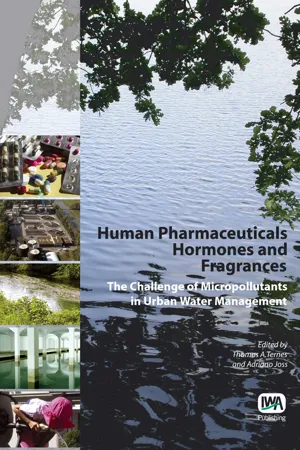
- 468 pages
- English
- PDF
- Available on iOS & Android
Human Pharmaceuticals, Hormones and Fragrances
About This Book
The observed concentrations of pharmaceuticals and personal care products (PPCPs) in raw wastewater confirm that municipal wastewater represents the main disposal pathway for the PPCPs consumed in households, hospitals and industry. In sewage treatment plant effluents most PPCPs are still present, since many of these polar and persistent compounds are being removed only partially or, in some cases, not at all. Treated wastewater therefore represents an important point source for PPCPs into the environment. After passing a sewage treatment plant the treated wastewater is mostly discharged into rivers and streams or sometimes used to irrigate fields. If drinking water is produced using resources containing a substantial proportion of treated wastewater (e.g. from river water downstream of communities) the water cycle is closed and indirect potable reuse occurs.
Human Pharmaceuticals, Hormones and Fragrancesprovides an overview of the occurrence, analytics, removal and environmental risk of pharmaceuticals and personal care products in wastewater, surface water and drinking water. The book covers all aspects of the fate and removal of PPCPs in the whole water cycle: consumption and occurrence, analytical methods, the legal background, environmental risk assessment, human and animal toxicology, source control options, wastewater and drinking water treatment as well as indirect reuse.
The book presents a summary of the results obtained during the EU project "Poseidon", combined with further expert knowledge on the field, and is written at a level appropriate for professionals involved in management of water resource quality. Professionals in the field including decision makers, engineers and scientists, as well as students entering the field, will find this an invaluable source of information. First comprehensive study on the assessment, fate and removal of pharmaceuticals and personal care products in wastewater and drinking water treatment. Emphasises the importance of micropollutants in the water cycle, provides methods for quantifying their fate and technologies for their removal.
Frequently asked questions
Information
Table of contents
- Contents
- Foreword
- Acknowledgement
- List of contributors
- 1 Introduction
- 2 Consumption and occurrence
- 3 Analytical methods
- 4a A brief overview on the legal background and the regulatory instruments of the environmental risk assessment for pharmaceuticals in the EU, USA, Japan, Australia and Canada
- 4b Environmental risk assessment
- 5 Human and animal toxicology of some water-borne pharmaceuticals
- 6 Wastewater treatment
- 7 Removal of PPCP during drinking water treatment
- 8 Indirect potable water reuse
- 9 Source control, source separation
- 10 Conclusions and outlook
- Annex
- Index